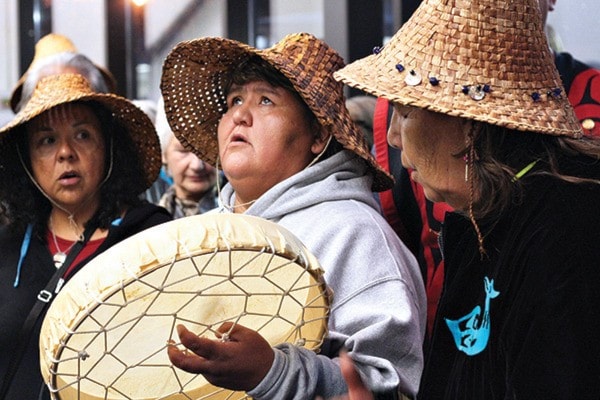Marina White, from the Kwakwaka’wakw Nation is a strong, self-determined and independent woman.
But for a long time she struggled with self-doubt because of traumas she endured at St. Michael’s residential school in Alert Bay.
“I was this innocent child who lived with her grandmother and lived with her parents,” she said. “My grandmother had so many teachings ... so much stuff she taught me about strength, determination, about honesty, about values.”
She was sent to residential school and it changed her.
“It was enough to impact my entire life, my entire being. It really affected me,” said White. “I am never the same again – never.”
In 1985 she started her healing with a therapist.
“I took back my power,” said White.
White shared her personal story with people gathered at the opening reception of The Witness Blanket exhibit, held at Vancouver Island University Thursday evening.
The Witness Blanket is a contemporary art installation created by master carver Carey Newman. It’s constructed out of items reclaimed from residential schools, churches, First Nations band offices, government buildings and friendship centres.
“My dad didn’t talk about his experience. I grew up knowing he had been there, but just not knowing very many things about his experience,” said Newman. “There was a lot of who I am as a person that is a direct result of his experience at a residential school.”
The Truth and Reconciliation Commission of Canada made a call for proposals for commemoration projects and Newman decided to create The Witness Blanket.
“I was really focused on doing something for my dad and also I wanted to tell the entire story, I didn’t want to just tell our personal family story,” said Newman. “I wanted there to be a monument for reconciliation that represented all survivors.”
Newman said he chose a blanket because it has cultural significance.
“We use them for comfort, for protection, to honour people, to identify ourselves, our regalia, our ceremonial wear,” he said. “I felt like a blanket was a welcoming thing.”
Douglas White III, Snuneymuxw First Nation councillor, also spoke about reconciliation at the event and moving beyond tolerance to embracing love.
“There is no doubt that absolutely we must create a more tolerant society, absolutely we must learn to accept each other, to stop hurting each other,” he said, adding that the work required for reconciliation can’t be answered with mere tolerance. “I believe that as a society we must strive for altruistic love and instead of the idea that some of us don’t matter, or we don’t matter to each other, is utterly thrown into the dustbin of history and replaced with the idea that we matter to each other. That I want my children to love your children.”
The exhibit is at The View Gallery at VIU campus until Nov. 30.
arts@nanaimobulletin.com
